All about the levisia plant
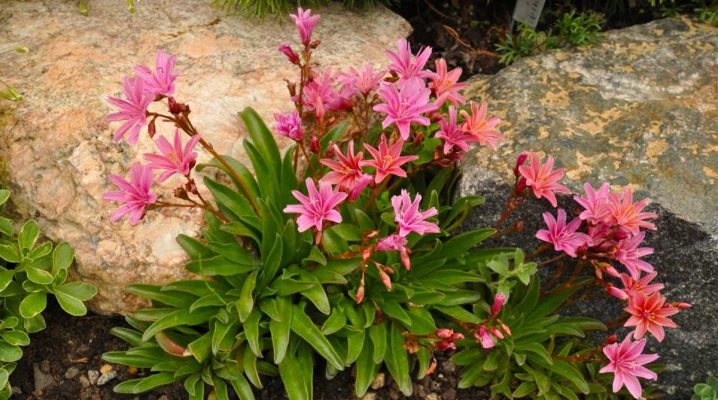
Knowing everything about the Levisia plant, gardeners will be able to properly grow it and get a real sense. Planting seeds and caring for a flower in the open field and at home should be done very carefully. Also noteworthy is the description of Levisia Cotyledon (blunt-leaved), Pygmies and other varieties.


Description
Levisia belongs to the Montium family; earlier this genus was mistakenly considered part of the purslane family. This is the most famous genus of the family, included in the order of cloves, and therefore the "distant relatives" of Levisia are:
- mesembriantemum;
- beet;
- Carnation;
- sundew;
- Venus flytrap;
- purslane;
- tamarisk;
- cacti.
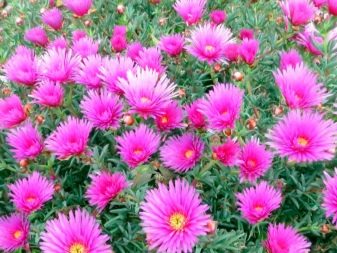
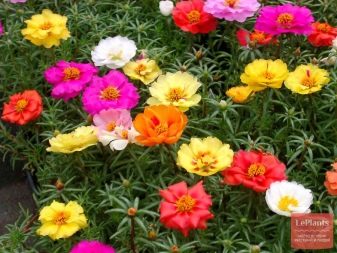
In nature, Levisia settles mainly in the western regions of the North American continent. The name of the plant type is given in honor of the discoverer. In total, the genus has about 20 species. Basically, Levisia lives in mountain areas from 800 to 4000 m. More often it gravitates towards rocky areas covered with rubble.
The long roots of the flower penetrate deep into the ground. Therefore, it can receive water even in relatively dry places. Perennial plants look pretty spectacular.... The flowers are shaped like a bowl. They are divided into a large number of petals.
Levisia leaves are strong. Basically, this plant has a ground cover form. With the beginning of spring, the finger-like foliage lengthens. When the leaves dry, they form dark pink, plain pink and sometimes white flowers that look great.
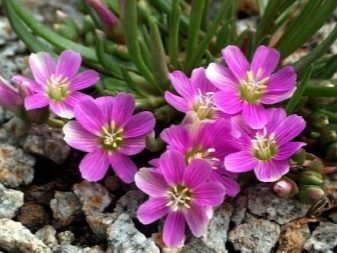

From the side it seems that the flowers have fallen to the ground. The section of a single flower is 40 mm. Sepals are grouped in 6-9 pieces. The flowers contain an average of 15 petals. Otherwise, this kind does not demonstrate any special subtleties.
Types and varieties
A fairly large number of varieties of this culture have been described. Levisia Cotyledon - also called lewisia Cotyledon or levisia dull-leaved - this plant belongs to the 5th zone in terms of resistance to frost. It grows to a maximum of 0.25 m. Growing is possible in the sun and in partial shade.
The coloration of blunt-leaved levisia is very different. Low watering requirements are characteristic. This plant is in demand by flower growers in various regions of our country. The tuberous rhizome is highly developed. Thanks to this, excellent survival rate is guaranteed even in mountainous areas.

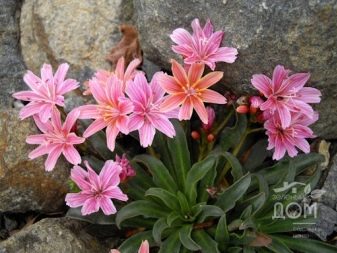
The variety is actively grown in the gardens. Pygmy, with the Latin name pygmaea. This is a dwarf type that can withstand the effects of mountain conditions. The height of the shrubs does not exceed 0.15 m. Elongated (up to 0.1 m) leaves are invariably narrow. The inflorescences are unusually beautiful.
The flowering of the Pygmy begins with the end of the frost. Each peduncle is capable of producing 7 buds. Each bud develops 15 petals. The unusual appearance is due to the fact that the cross-section of all flowers is 30 mm. When the dissolution occurs at the same time, the shrub is completely covered with white-pink petals. Reproduction by self-seeding and the associated rapid settlement of new sites are characteristic.
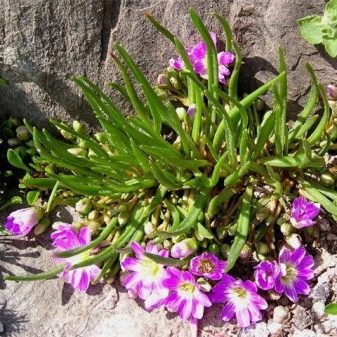
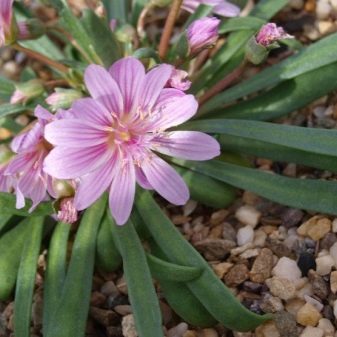
Long-petaled levisia has just that feature that is predictable for it by its name. The height of such a plant does not exceed 15 cm. It is characterized by leathery lanceolate leaves. The stems grow straight up. Flowering begins in May and continues until the end of June. Winter hardiness is relatively high, even against a background of high humidity in the cold season.
Among the long-petal levisia, the variety stands out Little Leach. It blooms much longer than the species sample - from May to August inclusive. The variety thrives on wet sand. The height of the culture reaches 30 cm. For its cultivation, it is necessary to choose sunny places.
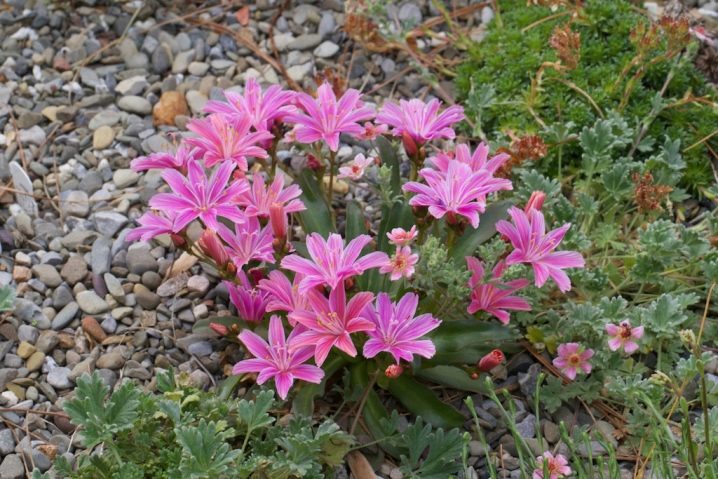
High humidity is also relevant for Nevada Levisia... The length of slightly curved leaves reaches 20 cm. Inflorescences are white or white-green in color. At night and in rainy weather, the buds are closed. You can see them only on clear days.
Levisia Alice - collection type for alpine slides. A bright pink color is typical for her. Flowering continues in May and June. High resistance of this type is noted during wintering under normal conditions. Alice's foliage forms wide rosettes.

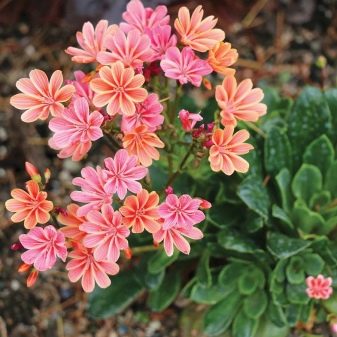
Short-celled levisia is a perennial herb... It sheds foliage as the cold season approaches. A large number of flowers develop on the peduncle. The section of the inflorescences is a maximum of 20 mm. Such a plant develops normally only in a relatively warm climate.
Colombian subtype - evergreen plant with a small-sized foliage rosette. Typical for him is a tall, not thick peduncle. In the upper part of the peduncle, white-pink flowers with bright streaks develop. Rosea looks sleeker than the species standard. Flowering begins in late spring and lasts until August.

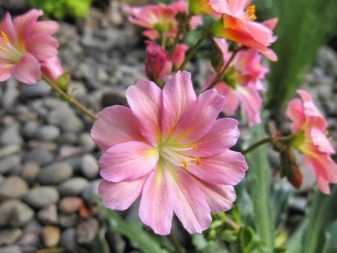
An important feature of Tweedy's Levisia is its foliage. It is large and broad, moreover, very fleshy. For this trait, the culture was even nicknamed "flowering cabbage." It turns purple or bright green. Leaf rosettes are very pretty, flowers are pleasantly perceived in conjunction with them.
Their cross section reaches 50 mm. Such flowers are characterized by attractive fruit shades - like orange, melon or apricot. At the edges of the petals, the basic tone is blurred, as if it were applied in watercolor. Coloring is flexible and mutable, can be hybrid.
Levisia Tweedy is extremely sensitive to winter dampness, and during frosty periods it should be dug up and moved to heated greenhouses.
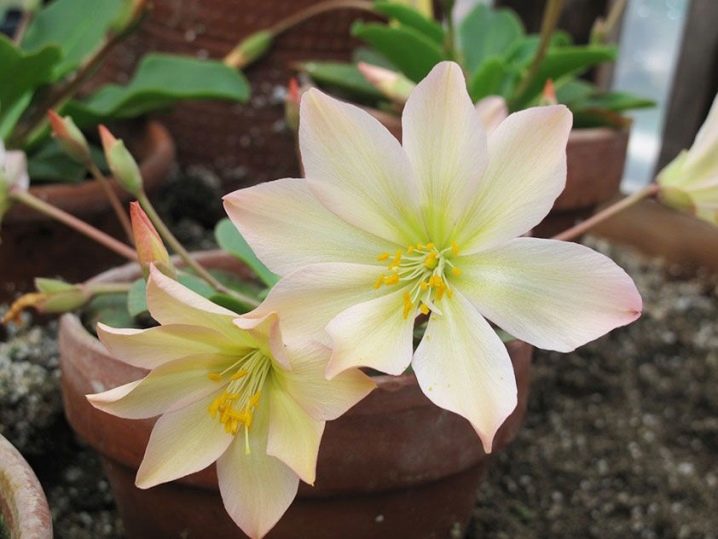
The Sierra breed also has an evergreen development. Its leaves are very graceful. They have characteristic serrations and are painted in a light gray tone. Flowers with 5 petals are disproportionately large for very thin peduncles. On the flowers, not only the main pale pink color is noted, but also dark pink veins contrasting with it; flowering continues in May, June and July.
The height of the Sierra type is no more than 6 cm. The section of flowers is about 1 cm. However, such a plant looks gorgeous on a rocky surface.
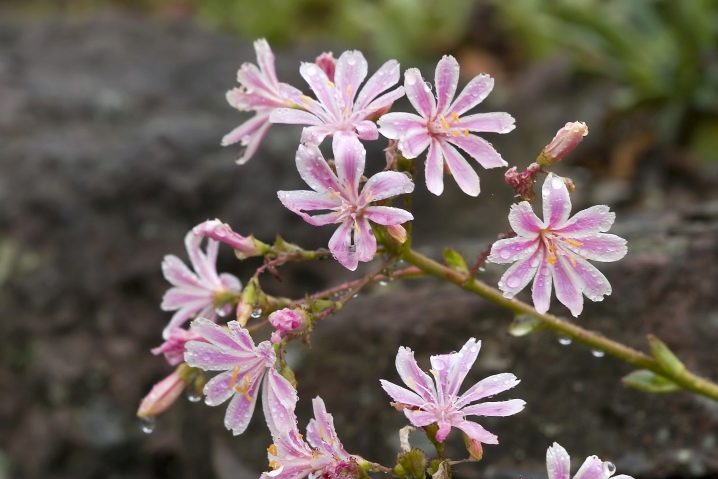
Visually, it can be confused with levisia. Cantelow... However, the difference immediately manifests itself in growth - at Cantelow the shoots are raised to 30 cm; the rosettes of this culture are created from leaves with a more pronounced serration.
Congdon's Levisia is even rarer and more valuable. It produces tall shoots and an impressive leafy rosette. This species grows up to 60 cm; its inflorescences include pastel pale pink flowers with dark veins. It usually blooms from mid-spring to about mid-summer. However, under favorable conditions, autumn flowering also occurs.
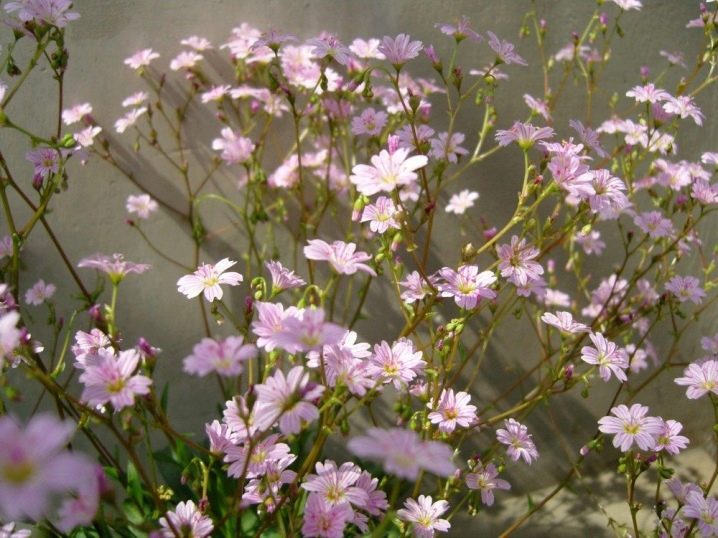
Landing
Preparing the land for cultivating Levisia at home is not difficult. For a plant to thrive, it needs first-class garden soil. The better its drainage and the level of fertility, the more attractive the result. This type of plant develops normally only in acidic soils. In addition to peat, sand, gravel, and humus are also used for acidification.
Sowing seeds is possible before winter (from mid to late October). It is advisable to choose a shade where direct sunlight does not fall. The best place is considered to be alpine slides, or rather, their western and eastern slopes. Seeds are covered by 5-10 mm and mulched with dry peat.Although shoots will appear in April, it will not be possible to count on flowering earlier than the second or third year.
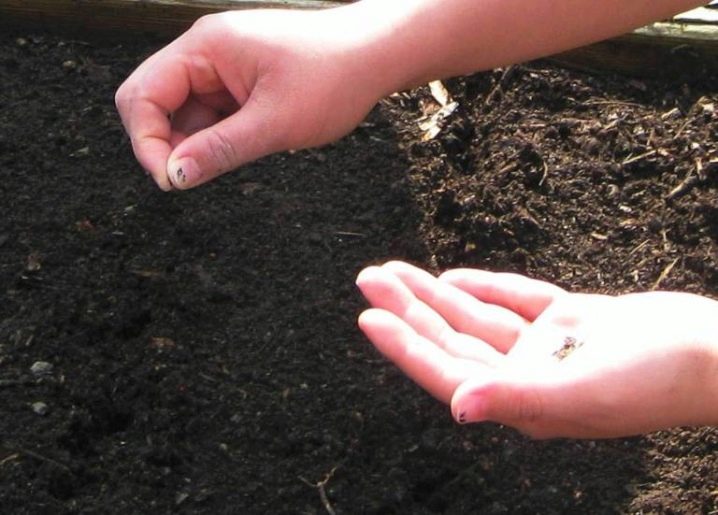
Levisia container culture also requires first-class soils. Usually, a universal substrate is used, in which the garden soil is mixed with a small amount of compost and sand. Such flowers bloom well only in a pot or container of small size. Due to the excess of land, the vegetation will come to the fore. Containers must be thoroughly drained and have holes for water outflow.
In the open ground, it is necessary to dig holes of great depth. 0.5 m of drainage material is placed there. When the seedling is set in its designated place, the neck of the root is gently covered with gravel.
Instead of gravel, stone chips can be used. Such a coating will exclude waterlogging of plants.

Care
Watering
Levisia in the open field is watered quite rarely. In fact, irrigation is carried out only in those periods when weather conditions require it. The ingress of water on the leaves is categorically unacceptable. Moreover, flowers and their buds should be protected from this. The agricultural technique of potted levisia implies the constant maintenance of a moderate moisture content in the substrate and drying out of the middle soil level.
Sometimes, due to the heat, the growth of the plant stops. In this case, watering is stopped. However, in return, you will have to spray the crop until it resumes its activity. In case of prolonged damp weather, the bushes are protected by covering them with plastic bottles.
It is necessary to carefully monitor that there is no stagnation of water near the roots.
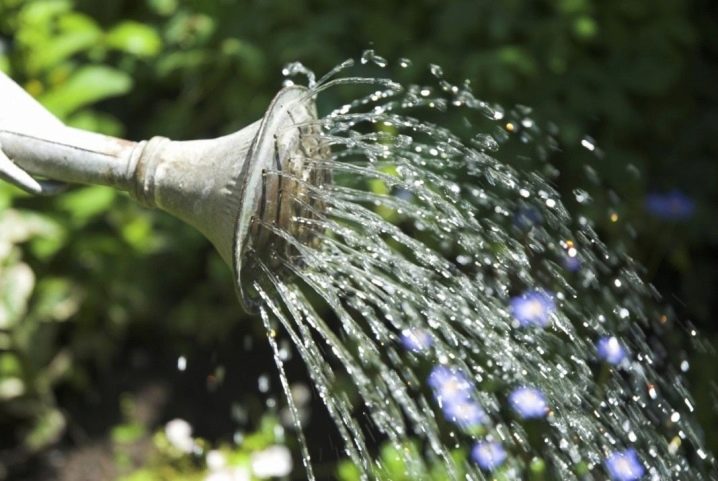
Fertilizer
When growing a North American plant, you cannot do without top dressing. But their excess is also contraindicated.... Usually, nutrients are loaded every 3-4 weeks, and this is quite enough. Mineral mixtures are undesirable for such a culture; organic matter is much better suited. It can be alternated with minerals.
An overfed plant usually hibernates very poorly, and in temperate latitudes, for successful wintering, it is enough to create a thick leaf cover in the garden.
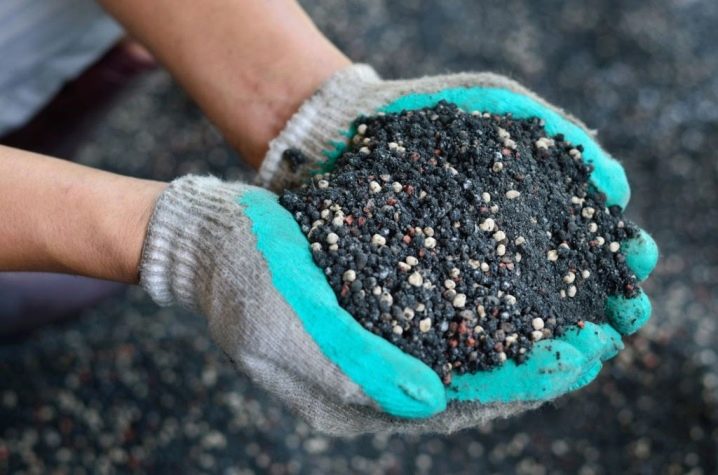
Pruning
Since plants bloom actively for most of the year, pruning is then perceived by them as painful. But the rapid growth of the bush still forces you to go for this procedure. Mostly faded flowers are cut off. Often after this, re-flowering begins. Withered and dried inflorescences are harvested freely throughout the year.
Pots with such a plant are best placed on the western or eastern windows. In the afternoon, active insolation is just important for a flower, but with diffused light. Evergreen types of culture are the most difficult to prepare for wintering. They are covered as carefully as possible, not skimping on barrier material - this is especially important north of the middle lane. Deciduous types do not pose this problem.
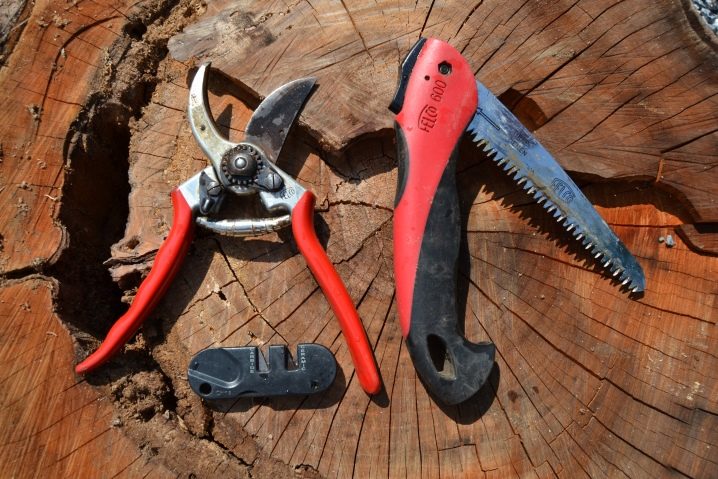
Reproduction
The classic sowing technique of reproduction is using seed beds. In this case, the soil must be covered with compost or thicker peat. Seed germination will occur only in April. The picking of seedlings is carried out carefully, it is better not to do it, in general, in the first year. The seedlings are then immediately transplanted to their final location.
Planting fresh seeds for seedlings is simplified by monthly cold stratification (which takes place after sowing); old planting material should not be used, because it quickly loses its condition. It is necessary to keep the planting material at a temperature of 0 to 5 degrees for about a month. Then it is rearranged into heat and light. As soon as the second real leaf has appeared, you can start picking - and you should not postpone it.
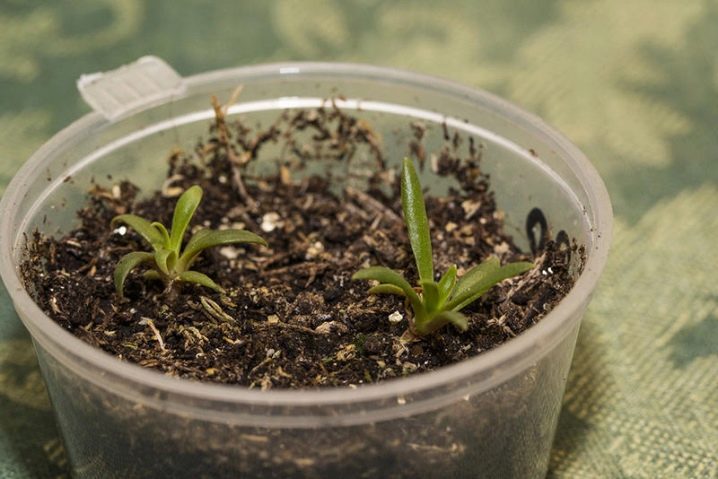
Cutting is possible for adult plants that have already formed lateral rosettes.
Cut them off carefully using a sharp knife. Shoots on the main bush should not be deformed. The slices are sprinkled with charcoal. The plots are germinated in a loose substrate in cool places.
Transfer to the final place of cultivation is possible only after the rooting of the levizia and the beginning of full growth.
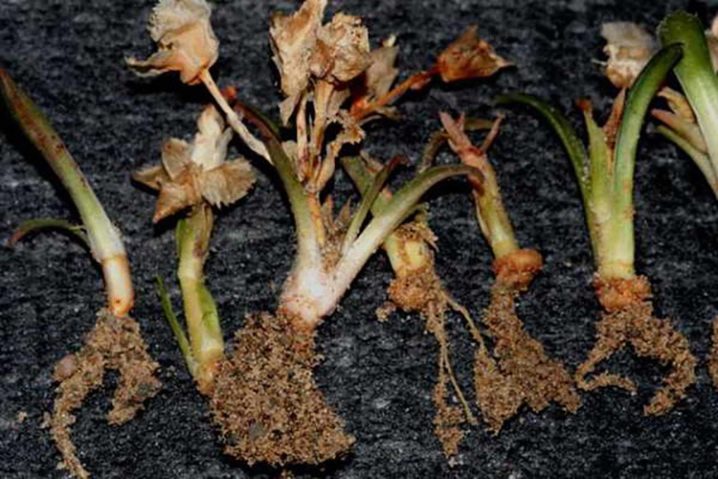
Diseases and pests
A particular risk is associated with gray mold. It appears in orange-gray patches on foliage. To combat such an infection, they resort to Oxyhom or Fundazol. A neglected disease is incurable, and all that remains is to get rid of the bush. The main pests are aphids and slugs; to combat them, in addition to "Fitoverm" and "Actellik", an infusion of garlic or a strong soap solution can be used.
Special traps will help increase insect resistance. It is also useful to follow the bushes and remove the first uninvited guests. Insecticides are used only strictly according to the instructions.
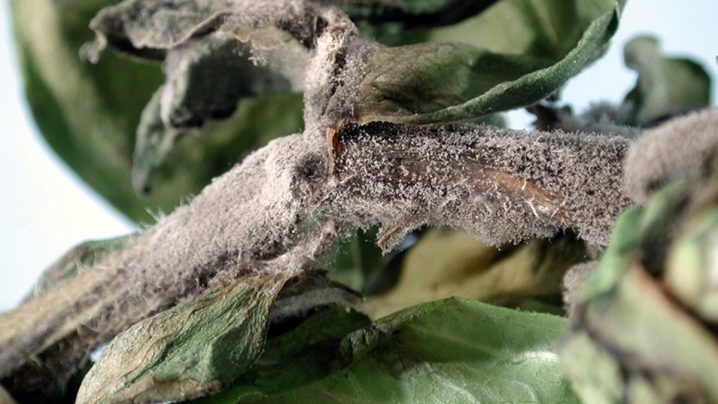
Use in landscaping
Levisia adds sophistication to rock gardens. It perfectly coexists with saxifrage and gentian; the bell is also considered a good companion. This species can also be grown in rockeries and in a stone niche. It is undesirable to choose areas with active sunlight.
If these conditions are met, levizia can even be added to ordinary flower combinations or used as a ground cover.
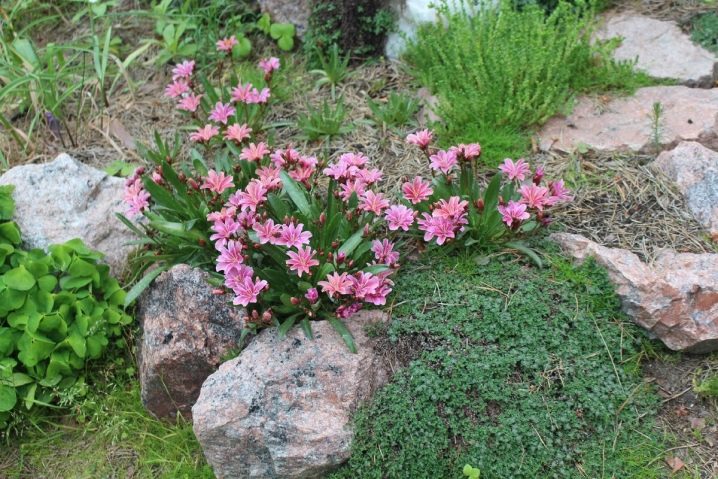













The comment was sent successfully.